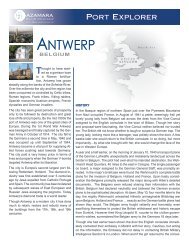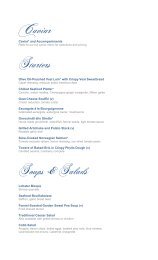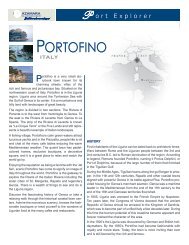Download Port Explorer Guide - Azamara Club Cruises
Download Port Explorer Guide - Azamara Club Cruises
Download Port Explorer Guide - Azamara Club Cruises
Create successful ePaper yourself
Turn your PDF publications into a flip-book with our unique Google optimized e-Paper software.
RIO DE JANEIRO<br />
BRAZIL<br />
Can you name the only former<br />
European capital that<br />
was separated from its own country by nearly 5,000<br />
miles of Atlantic Ocean and located on the eastern<br />
coast of South America? If you happen to be from<br />
São Sebastião do Rio de Janeiro you probably already<br />
know the answer.<br />
For nearly two centuries beginning in 1763 as the<br />
capital of the <strong>Port</strong>uguese colony, through the country’s<br />
independence in 1822 and up to 1960, Rio de<br />
Janeiro was the seat of Brazil’s government. It was<br />
during the Napoleonic war in 1808 and Bonaparte’s<br />
invasion of <strong>Port</strong>ugal that the Royal family and its<br />
courtiers fled Lisbon and set up their government<br />
in exile in Rio.<br />
Over the past half century Rio has earned a reputation<br />
for its beauty and exciting lifestyle. The city is<br />
famous for its wild beaches and outrageous Carnival<br />
celebrations. It lies between the sea and several<br />
fertile green mountains, including Pão d’Açucar<br />
(Sugarloaf) Mountain, and Corcovado, home to the<br />
famous art-deco statue of Christ the Redeemer.<br />
Lined with 23 beaches along its coast, its most famous,<br />
Copacabana and Ipanema, are teeming with<br />
bikers, walkers, joggers, surfers, swimmers and<br />
sunbathers, all enjoying the scene as much as the<br />
sun. This is a dynamic city that draws visitors from<br />
all over the world.<br />
HISTORY<br />
<strong>Port</strong>uguese explorer Gaspar de Lemos under the leadership of Captain<br />
Andre Gonçalves discovered Guanabara Bay on January 1, 1502.<br />
Some, even today, tell the story that the first settlement got its name,<br />
Rio de Janeiro (The River of January) due to De Lemos mistaking the<br />
bay for the mouth of a large river. This explanation is apocryphal at<br />
best. Keep in mind the fact that <strong>Port</strong>ugal is the home of great sailors,<br />
navigators and explorers like Prince Henry, Ferdinand Magellan, Vasco<br />
da Gama, Bartholomeu Dias, Diogo Cao and Pedro Alvares Cabral.<br />
There can be no doubt that Captain Gaspar de Lemos knew the difference<br />
between a river and a bay. None the less, from a small settlement<br />
Rio de Janeiro would soon grow to become the economic, cultural and<br />
political capital of Brazil.<br />
Upon its discovery, Guanabara Bay was ringed with numerous native<br />
villages. As the indigenous tribes of Brazil had no written language very<br />
little is known about the people before the arrival of the <strong>Port</strong>uguese.<br />
On April 22, 1500, <strong>Port</strong>uguese navigator and explorer Pedro Alvares<br />
Cabral came ashore in northeast Brazil … planted a cross and flag in<br />
the sand, claimed the land in the name of his king Manuel I and the<br />
Holy Roman Church … then promptly sailed away.<br />
It would not be until 1549 that <strong>Port</strong>ugal would send a governor together<br />
with six Jesuits priests whose task it would be to civilize and convert to<br />
Roman Catholicism Brazil’s native population. Sugarcane plantations<br />
were quickly expanded. Through African labor colonial Brazil soon<br />
supplied most of the Old World’s sugar while <strong>Port</strong>ugal, on land and<br />
sea, soon dominated the slave trade in the New World.
© 2013 maps.com<br />
2<br />
1<br />
3<br />
4<br />
5 6<br />
Brazil declared its independence from <strong>Port</strong>ugal on September<br />
7, 1822, after three centuries of colonial rule. Monarchies, military<br />
juntas, dictatorships and eventually Republican Democracies<br />
have followed in randomly rotating succession. Brazil’s<br />
National Indian Foundation (Fundação Nacional do Indio) has<br />
worked hard to protect the country’s indigenous population<br />
yet estimates that fewer than ½ million native people survive<br />
today and that just over 20 small tribes still try to refrain from<br />
contact with the world outside their own.<br />
RIO DE JANEIRO PLACES OF INTEREST<br />
1<br />
Palácio da Ilha Fiscal is one of the most beautiful gothic<br />
style buildings in all of Rio. The shimmering green palace<br />
was built on the instructions of Brazil’s Emperor Dom Pedro<br />
II in 1889 and stands elegantly looking out over Guanabara<br />
Bay. The palace underwent extensive renovation in 2000. The<br />
elaborate rooms, beautiful paintings, ornate ceilings and stunning<br />
stained glass windows all come together to draw visitors<br />
back to a gilded age long past. The large clock in the tower<br />
of the palace was used by ship navigators of the era to synchronize<br />
their timepieces for accurate course charting. And<br />
speaking of timing…the completion of the palace took place<br />
just a few days before Emperor Dom Pedro II was deposed,<br />
sent into exile and Brazil declared a republic.<br />
2<br />
The Espaço Cultural da Marinha (Navy Cultural Center)<br />
is Rio’s nautical museum. It traces the city’s long<br />
relationship with the sea. It was from the sea, after all, that
the beautiful bay was discovered by <strong>Port</strong>uguese sailors.<br />
The museum is located at the waterfront docks.<br />
The displays include artifacts that have been recovered<br />
from underwater archaeological sites as well as<br />
navigational instruments, charts and numerous ship<br />
models. Outside at the pier are two 20th century war<br />
ships that are a part of the museum and open to the<br />
public.<br />
3<br />
Museu Histórico da República is a fascinating<br />
museum that presents the history of Brazil. The<br />
museum is located in the Palácio do Catete. Built in the<br />
late 1850s this beautiful building was the governmental<br />
offices of the country’s presidents until the capital was<br />
moved to Brasilia in the 1960s. Among the thousands<br />
of pieces on exhibit the museum displays colonial military<br />
paraphernalia and Catholic religious art. One of<br />
the most poignant exhibits is that of former president<br />
Getúlio Vargas who, in 1954, embroiled in political<br />
scandal and facing a military coup, in the apartment<br />
adjoining his presidential office, took his own life.<br />
4<br />
The Cristo Monument atop Morro de Corcovado<br />
is the iconic image of Rio. The 100 foot high 1,145<br />
ton monument was put in place in 1931 and looks out<br />
over the city, bay and surrounding countryside from<br />
an elevation of 2,400 feet. From the base of Mount<br />
Corcovado visitors can take a cogwheel train to the top<br />
for an incredible 360 degree view.<br />
5<br />
The Jardim Botanico is one of the most beautiful<br />
gardens in the country … if not the world. Spreading<br />
out over 300 acres the garden was built on the<br />
instructions of King João VI in the early 1900s. The<br />
garden has over 8,000 species of plants, flowers and<br />
trees from Brazil and around the world. Together with<br />
ponds, fountains and greenhouses the garden also<br />
has a botanical museum.<br />
6<br />
The Copacabana Boardwalk stretches along one<br />
of the most famous beaches in the world. One of<br />
the architectural highlights is the elegant Copacabana<br />
Palace Hotel. Built in 1923, this classic grande dame<br />
has played host to royalty and great stars of stage<br />
and screen. Along the boardwalk there are wonderful<br />
cafes and restaurants, interesting shops and classy<br />
boutiques. For those who do not wish to walk, bicycle<br />
rentals are available.<br />
Beyond Rio de Janeiro<br />
Petropolis is a beautiful resort town nearly 3,000 feet<br />
up in the mountains outside Rio. It was a favorite summer<br />
getaway for Brazil’s Emperor<br />
Dom Pedro II. The Palace holds an<br />
amazing collection from the country’s<br />
imperial era.<br />
SHORE EXCURSIONS<br />
To make the most of your visit to Rio De Janeiro and surrounding<br />
areas we suggest you take one of our organized Shore Excursions.<br />
For information concerning tour content and pricing, consult your<br />
Shore Excursion Brochure or contact the Shore Excursion Desk.<br />
When going ashore, be advised to take with you only the items you<br />
need and secure any valuables onboard.<br />
LOCAL CUSTOMS<br />
Bargaining: Prices are generally fixed however some small shops<br />
may bargain.<br />
Tipping: A 10% tip is customary at restaurants.<br />
LOCAL CUISINE AND DRINK SPECIALTIES<br />
Brazil is a large country but most of the population is found along<br />
the Atlantic coast. Brazil’s cuisine has been primarily influenced<br />
by European immigrants and the descendents of former African<br />
slaves. Many of the dishes are regional. Some of favorites include:<br />
Feijoada is roasted pork with black beans and rice. Churrasco is<br />
flame grilled meats sliced from a skewer.<br />
Cachaca is very strong liquor made from sugarcane. It is often<br />
mixed with lime, sugar and crushed ice to make a cocktail know as<br />
Caipirinha.<br />
SHOPPING FACILITIES<br />
Brazil is well known for its fine crafts. Wood carvings, terra cotta<br />
pottery, amazing jewelry, colorful fabrics and lace, vibrant paintings<br />
and sculpture, hand woven hammocks and the cutest and best<br />
made bikinis in the world are some of the favorite items to buy in<br />
Rio.<br />
Like any major city where there are street vendors, some in Rio can<br />
be very persistent. If you are not interested in their products simply<br />
continue on your way.<br />
LOCAL CURRENCY<br />
Brazil’s currency is the Real (BRL). Many shops and vendors will<br />
accept U.S. dollars in small denominations. Major credit cards are<br />
widely accepted however some shops offer discounts if the item is<br />
paid for in cash.<br />
POST OFFICE AND TELEPHONE FACILITIES<br />
There is a Post Office is located at Rio Branco Avenue, a short walk<br />
from the pier.<br />
Dial the following access numbers to use a personal calling card:<br />
AT&T: 0.800.890.0288<br />
MCI: 0.800.890.0012<br />
TRANSPORTATION<br />
Taxis are widely available at the pier.<br />
TOURIST INFORMATION<br />
There is a Tourist Information Counter inside the cruise ship terminal.
USEFUL WORDS AND PHRASES<br />
The official language of Brazil is <strong>Port</strong>uguese.<br />
Hello - Alô<br />
How are you? - Tudo bom?<br />
Thank you - Obrigado<br />
You are welcome - De nada<br />
Yes - Sim<br />
No - Não<br />
Good bye - Tchau (like the Italian “ciao”)<br />
__________________________________________________________________________________<br />
__________________________________________________________________________________<br />
__________________________________________________________________________________<br />
__________________________________________________________________________________<br />
__________________________________________________________________________________<br />
__________________________________________________________________________________<br />
__________________________________________________________________________________<br />
__________________________________________________________________________________<br />
__________________________________________________________________________________<br />
__________________________________________________________________________________<br />
__________________________________________________________________________________<br />
__________________________________________________________________________________<br />
__________________________________________________________________________________<br />
__________________________________________________________________________________<br />
__________________________________________________________________________________<br />
__________________________________________________________________________________<br />
__________________________________________________________________________________<br />
__________________________________________________________________________________<br />
__________________________________________________________________________________<br />
__________________________________________________________________________________<br />
__________________________________________________________________________________<br />
__________________________________________________________________________________<br />
__________________________________________________________________________________<br />
__________________________________________________________________________________<br />
__________________________________________________________________________________<br />
__________________________________________________________________________________<br />
This information has been compiled for the convenience of our guests and is intended solely for that purpose. While we work to ensure that the information contained herein is correct, we cannot accept responsibility<br />
for any changes that may have taken place since printing.<br />
© RCCL 2013 - All rights reserved.
















